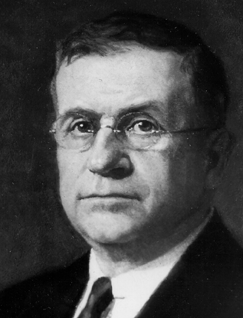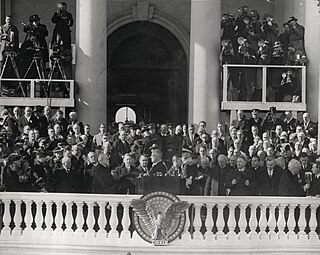For the presidency of Franklin D. Roosevelt, see:

Franklin Delano Roosevelt, often referred to by his initials FDR, was an American politician who served as the 32nd president of the United States from 1933 until his death in 1945. A member of the Democratic Party, he won a record four presidential elections and became a central figure in world events during the first half of the 20th century. Roosevelt directed the federal government during most of the Great Depression, implementing his New Deal domestic agenda in response to the worst economic crisis in U.S. history. As a dominant leader of his party, he built the New Deal Coalition, which defined modern liberalism in the United States throughout the middle third of the 20th century. His third and fourth terms were dominated by World War II, which ended shortly after he died in office.

The Twenty-second Amendment to the United States Constitution limits the number of times a person is eligible for election to the office of President of the United States to two, and sets additional eligibility conditions for presidents who succeed to the unexpired terms of their predecessors.
This section of the Timeline of United States history concerns events from 1930 to 1949.
President Roosevelt may refer to:

Henry Morgenthau Jr. was the United States Secretary of the Treasury during most of the administration of Franklin D. Roosevelt. He played a major role in designing and financing the New Deal. After 1937, while still in charge of the Treasury, he played the central role in financing United States participation in World War II. He also played an increasingly major role in shaping foreign policy, especially with respect to Lend-Lease, support for China, helping Jewish refugees, and proposing to prevent Germany from again being a military threat.

Harold LeClair Ickes was an American administrator and politician. He served as United States Secretary of the Interior for 13 years, from 1933 to 1946, the longest tenure of anyone to hold the office, and the second longest-serving Cabinet member in U.S. history after James Wilson. Ickes and Labor Secretary Frances Perkins were the only original members of the Roosevelt cabinet who remained in office for his entire presidency.

The Franklin D. Roosevelt Presidential Library and Museum holds the records of Franklin Delano Roosevelt, the 32nd President of the United States (1933–1945). Located on the grounds of Springwood, the Roosevelt family estate in Hyde Park, New York, the library was built under the President's personal direction in 1939-1940, and dedicated on June 30, 1941. It is the first presidential library in the United States and one of the thirteen presidential libraries under the auspices of the National Archives and Records Administration.

The 77th United States Congress was a meeting of the legislative branch of the United States federal government, composed of the United States Senate and the United States House of Representatives. It met in Washington, DC from January 3, 1941, to January 3, 1943, during the ninth and tenth years of Franklin D. Roosevelt's presidency. The apportionment of seats in the House of Representatives was based on the Sixteenth Census of the United States in 1940. Both chambers had a Democratic majority.

The 79th United States Congress was a meeting of the legislative branch of the United States federal government, composed of the United States Senate and the United States House of Representatives. It met in Washington, DC from January 3, 1945, to January 3, 1947, during the last months of Franklin D. Roosevelt's presidency, and the first two years of Harry Truman's presidency. The apportionment of seats in this House of Representatives was based on the Sixteenth Census of the United States in 1940. Both chambers had a Democratic majority.

The 76th United States Congress was a meeting of the legislative branch of the United States federal government, composed of the United States Senate and the United States House of Representatives. It met in Washington, DC from January 3, 1939, to January 3, 1941, during the seventh and eighth years of Franklin D. Roosevelt's presidency. The apportionment of seats in the House of Representatives was based on the Fifteenth Census of the United States in 1930. Both chambers had a Democratic majority. It is the most recent Congress to have held a third session.

The third inauguration of Franklin D. Roosevelt as President of the United States was held on Monday, January 20, 1941, at the East Portico of the United States Capitol in Washington, D.C. This was the 39th inauguration and marked the commencement of the third, and eventually final full term of Franklin D. Roosevelt as President and the only term of Henry A. Wallace as Vice President. This was the first and only time a president has been inaugurated for a third term; after the Twenty-second Amendment to the United States Constitution was ratified in 1951, no person can be elected president more than twice.

The fourth inauguration of Franklin D. Roosevelt as President of the United States was held on Saturday, January 20, 1945. This was the 40th inauguration and marked the commencement of the fourth and final term of Franklin D. Roosevelt as president and the only term of Harry S. Truman as vice president. This was the first and only time a president has been inaugurated for a fourth term; after the Twenty-second Amendment to the United States Constitution was ratified in 1951, no person can be elected president more than twice. Roosevelt died 82 days into this term, and Truman succeeded to the presidency.
The second inauguration of Franklin D. Roosevelt as President of the United States was held on Wednesday, January 20, 1937, at the East Portico of the United States Capitol in Washington, D.C. This was the 38th Presidential inauguration and marked the commencement of the second term of Franklin D. Roosevelt as President and John Nance Garner as Vice President. It was the first inauguration to take place on January 20 per the 20th Amendment to the U.S. Constitution. This was also the first time the vice president took the oath of office on the inaugural platform rather than in the Senate Chamber.
Inauguration of Franklin D. Roosevelt may refer to:

The 1936 United States presidential election in New York took place on November 3, 1936. All contemporary 48 states were part of the 1936 United States presidential election. Voters chose 47 electors to the Electoral College, which selected the president and vice president.
This Bibliography of Franklin D. Roosevelt is a selective list of scholarly works about Franklin D. Roosevelt, the thirty-second President of the United States (1933–1945).

The third presidential term of Franklin D. Roosevelt began on January 20, 1941, when he was once again inaugurated as the 32nd President of the United States and the fourth term of Roosevelt's presidency ended with his death on April 12, 1945. Roosevelt won a third term by defeating Republican nominee Wendell Willkie in the 1940 United States presidential election. He remains the only president to serve for more than two terms. Unlike his first two terms, Roosevelt's third and fourth terms were dominated by foreign policy concerns, as the United States became a belligerent in World War II in December 1941.
The foreign policy of the Franklin D. Roosevelt administration was the foreign policy of the United States from 1933 to 1945, under the Presidency of Franklin D. Roosevelt, first and second terms, and the Presidency of Franklin D. Roosevelt, third and fourth terms. Roosevelt kept personal control of foreign-policy in the White House, and for that he depended heavily on Henry Morgenthau Jr., Sumner Welles, and Harry Hopkins. Meanwhile, Secretary of State Cordell Hull handled routine matters; the president ignored Hull on most major issues. Roosevelt was an internationalist, and Congress favored more isolationist solutions, so there was considerable tension before the Attack on Pearl Harbor in December 1941. During the war years, treaties were few, and diplomacy played a secondary role in high-level negotiations with the Allies of World War II, especially Britain's Winston Churchill and the Soviet Union's Joseph Stalin.